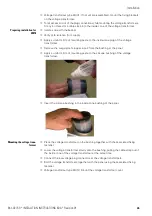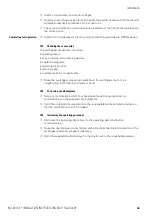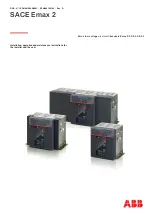
fåëí~ää~íáçå
34
oÉîáëáçå=MP=G=fkpq^iiqflk=fkpqor`qflkp=Ua^=G=USNJVOTPKV=
!
The limit value indicators on the pressure indicator of the busbar run have been pre-
adjusted at the factory. Check the limit pressures according to the table and the
graphics, and correct with the supplied square socket spanner in case of deviations.
Completing the assembly of
further busbar runs and fill-
ing with SF
6
-gas
!
Fill all other busbar runs as described above (see Page 30, "Completing busbar
assembly and filling with SF
6
-gas").
8.2
Assembling panel connections supplied separately and filling circuit-breaker housings
with SF
6
-gas
When panel connections are supplied separately, the circuit-breaker housing is not filled
with SF
6
-gas at the factory.
To expose the desiccant bags as briefly as possible to the ambient air, the installation
work described hereafter is performed
completely on one circuit-breaker housing in
one panel
.
Assembling panel connec-
tions supplied separately
!
Remove the provisional cover underneath the circuit-breaker housing.
!
Prepare the flange of the circuit-breaker housing and the flange of the panel
connection for assembly (see Section "Preparing the flanges of the busbar housings",
Page 24).
!
Bolt the panel connection crosswise to the flange of the circuit-breaker housing
using M8x45 bolts
a
, contact washers
s
, plain washers
d
and with one insulating
sleeve
f
each. Tightening torque: 20 Nm.
!
Connect the earthing cable.
ATTENTION!
Desiccant bags that have been fitted in the circuit-breaker housings at the factory are
not effective anymore if the housings remain open for more than half an hour.
!
Replace desiccant bags in circuit-breaker housings that have been open for more
than half an hour.
Fig. 24: Bolted joint of flange for
panel connections
a
Bolt M8x45
s
Contact washer
d
Plain washer
f
Insulating sleeve








































